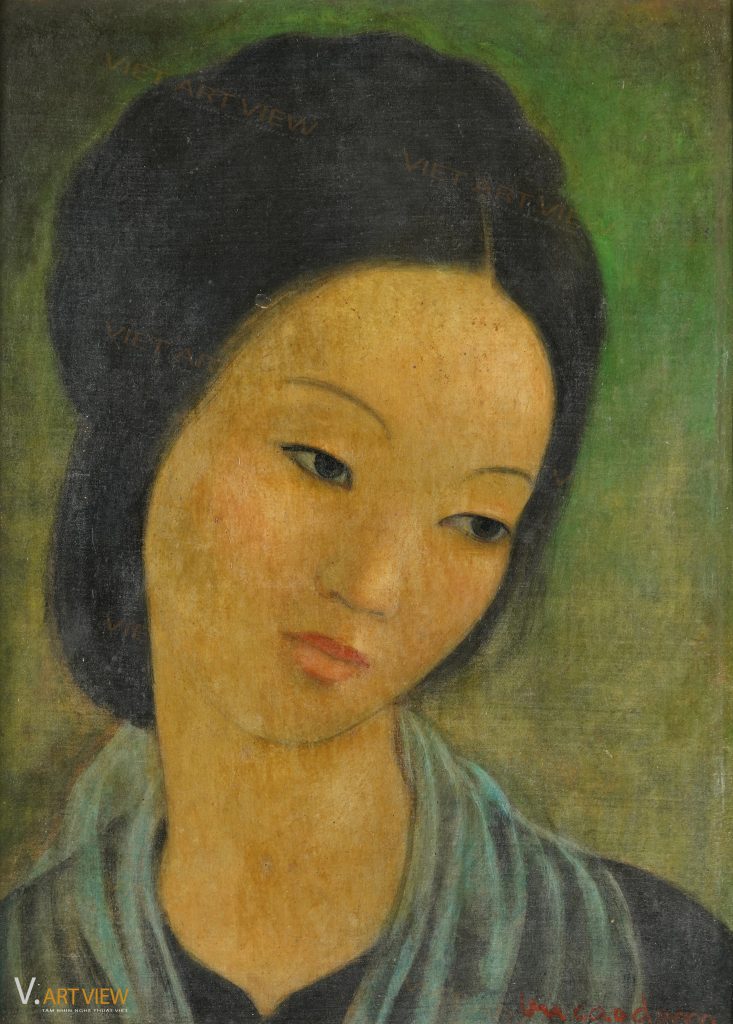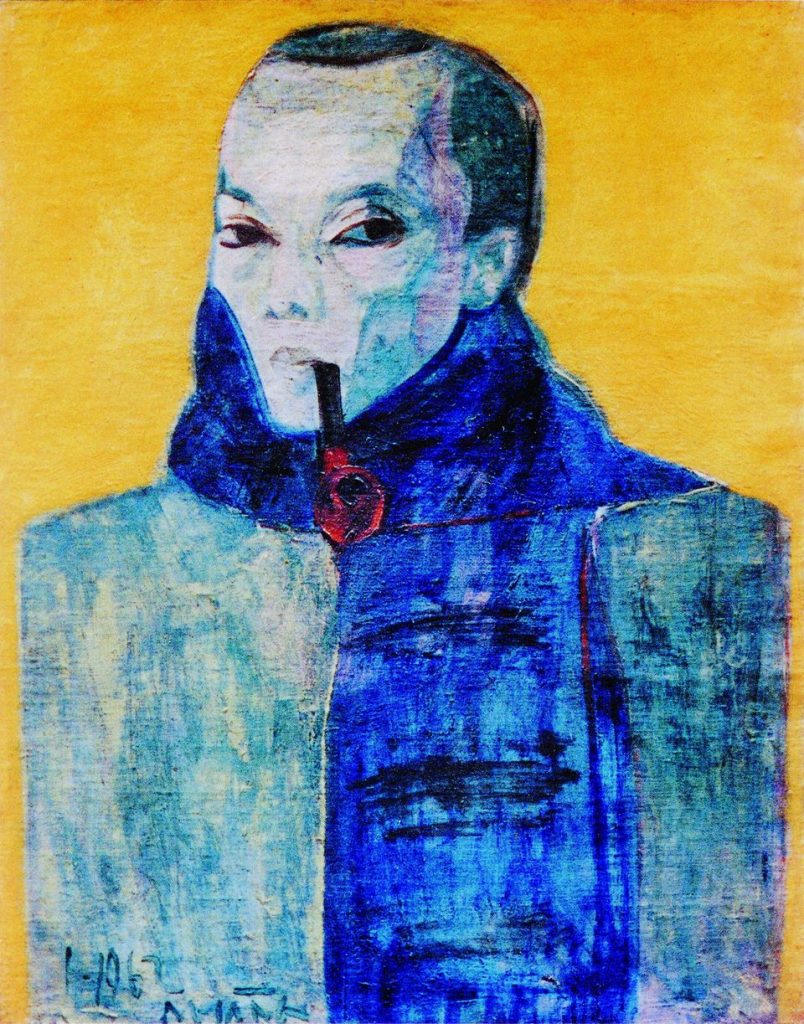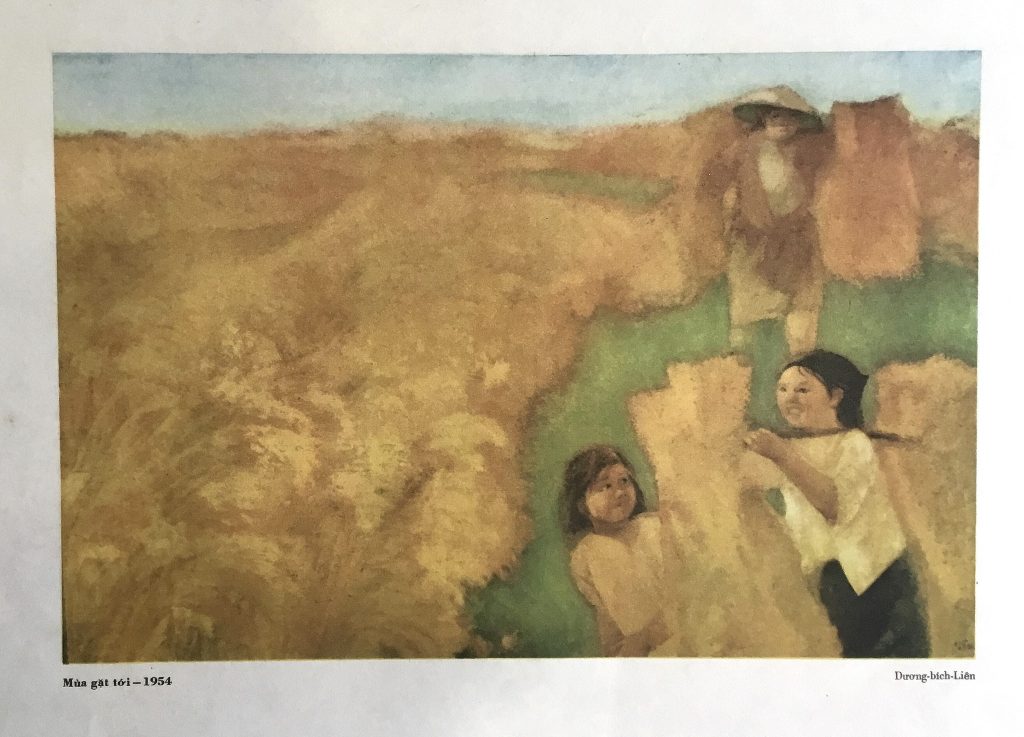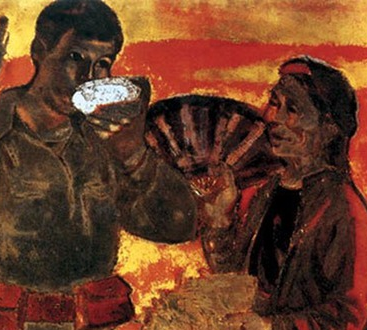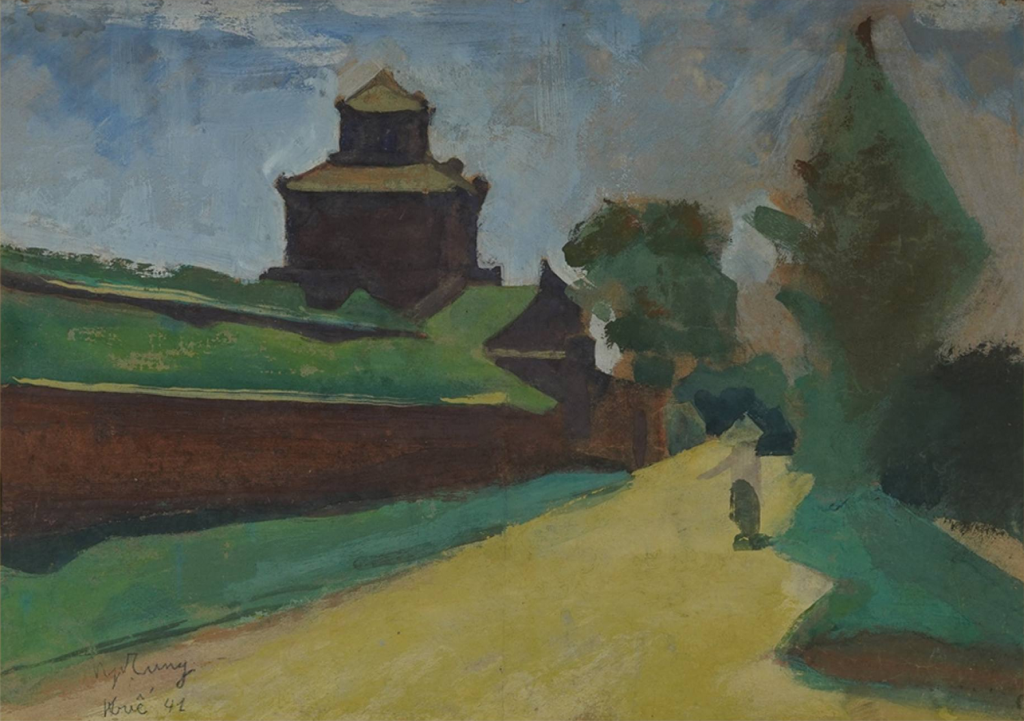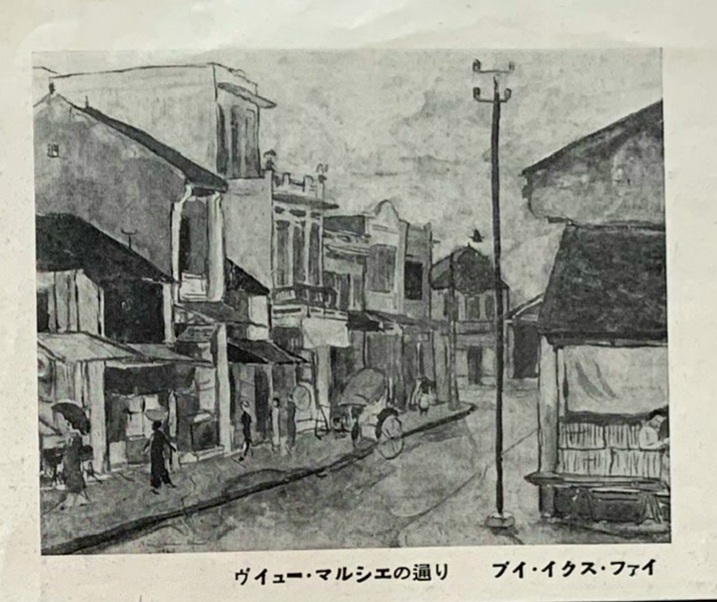
Mai Văn Hiến (1923-2006). Uncle Hồ and the courier. 1990-1991. Oil. 130×170cm. Private collection, Hà Nội.
Painter Mai Văn Hiến with revolutionary romantic realist style
Painter Mai Văn Hiến was born in 1923 in Đà Nẵng. He studied in class 17 (1943-1945) at Indochina Fine Arts College with Mai Văn Nam, Lê Thanh Đức, Phạm Tăng. During the resistance war against the French, he participated in the revolution and painted many propaganda pictures. Especially, in 1946, he drew the first banknote for the Government of Việt Nam. In 1954, he participated in the Điện Biên Phủ campaign. Although he worked with a variety of themes, his typical works are related to the themes of revolutionary war and the leader.
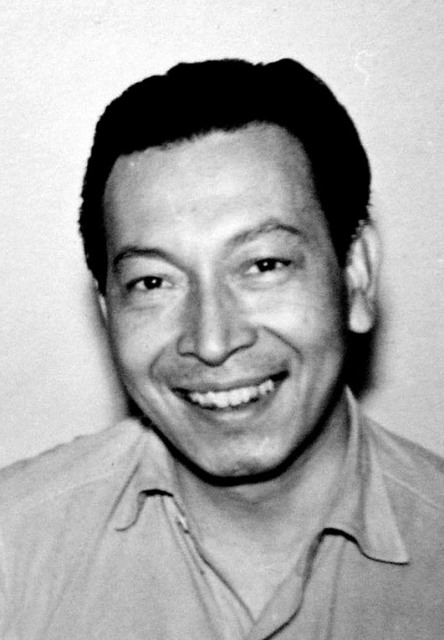
Portrait of painter Mai Văn Hiến (1923-2006)
Working a lot on the theme of war, we rarely see him depicting scenes of smoke, fire, bombs; the cruelty on the battlefield. He loved what is pure, gentle, romantic and playful behind the “front line” in the style of romantic realism such as: “Meeting” 1954, gouache, 80×100 cm; “Before going to the drill-ground” 1956, oil, 70×90 cm; “Flowers in barracks” 1956, 80×80 cm; “Butterflies along the way” 1984, oil, 74×100cm; “Evaporating dew” 1992, oil, 60×90 cm; “Singing in the campaign season” 1994, oil, 120×180 cm. The leader-themed such as: “The right things” 1958, oil, 80×120 cm (Việt Nam Fine Arts Museum); “Uncle Hồ and the courier” 1990, 1991, oil, 130×170 cm; “Uncle Hồ returning the country to lead the revolution” 1995, oil, 100×160 cm…
In his works, in addition to the young and old characters, we see the poetic, lyrical, and beautiful mountain scenery with soft, cool colors and bright, radiant smiles; see a classic academic technique in shaping. The composition is concise, the shaping is solid, the proportions are balanced. The lines are always just enough to create softness and continuity for the shapes.
With the affections of family, friends and fellows about a humorous, witty, kind and sincere Mai Văn Hiến; in the eyes of professionals, Mai Văn Hiến’s painting is optimism, love of the homeland, the noble human spirit of sacrifice for the country exudes from the characters. The landscape of homeland also became extremely beautiful under his eyes.
In “Uncle Hồ and the courier” is the same. With the theme of the leader, the theme of revolution… but what Mai Văn Hiến portrayed in the painting is very calm and peaceful. Because for him, what is most fierce like war, or as serious as historical theme, leader theme are handled according to his own romantic language and style. It is gentle and peaceful, but the work carries in it the love for the homeland and the revolutionary will as strong as the vitality of the new spring.
Special features in the work “Uncle Hồ and the courier”
The work “Uncle Hồ and the courier” is a special work. First of all, the painting has four different names:
– The first name “Going to the stream in the morning…” which Mai Văn Hiến captioned for the watercolor sketch on paper.
– The second name “Uncle Hồ in Pác Bó” in the exhibition “Priceless works of Vietnamese painting” in 2012.
– The third name “The tottering stone table” in the book “Vietnamese painting with a different look”.
– The fourth name “Uncle Hồ and the courier” in the book “Painter Mai Văn Hiến”, edited by art critic Mai Thị Ngọc Oanh (daughter of painter Mai Văn Hiến).

The sketch “Going to the stream in the morning…”
The sketch “Going to the stream in the morning…” of painter Mai Văn Hiến was inspired by “Poetry by the scene of Pác Bó” composed by Uncle Hồ in February 1941:
Go to the stream in the morning and back to the cave in the evening
Ready with corn porridge and bamboo shoots
The Party’s history on the tottering stone table
A life of revolution is truly luxurious.
Art critic Mai Thị Ngọc Oanh said that “after transforming from watercolor to oil, painter Mai Văn Hiến officially named the painting “Uncle Hồ and the courier”. Basically, the title sometimes simply describes what is depicted on the surface of the work. When artists create, they want to convey more than “a message from the name”.
In the work, the image of Uncle Hồ and the courier reminds viewers of the subject image of the leader – Uncle Hồ and the courier – representing those who were enlightened to the revolution at that time. The painting depicts a majestic nature, under the foliage of forest trees, next to the cool stream is the image of President Hồ sitting at the stone table giving the “official dispatch” to the courier. At that time, He had different couriers, helping to communicate, deliver His commands to various secret revolutionary bases in Cao Bằng.
When making paintings with the theme of Uncle Hồ, the image of the leader is usually placed in the center. Some paintings also use convention, depicting Him greater than other characters.
However, painter Mai Văn Hiến portrayed a deliberate leader in the midst of a vast landscape of mountains and water. This is probably one of the two oil paintings with the largest framework among Mai Văn Hiến’s works, with dimensions 130×170cm (The other painting is “Singing in the campaign season”, 120×180cm) took two years (1990-1991).
The painting “Uncle Hồ and the courier” is like a slice of historical footage of Vietnam revolution. The work represents an important period when Uncle Hồ was secretly operating at Pác Bó base. However, the details depicted in the work are extremely gentle and peaceful. In the painting, the two characters blend with the majestic nature. Viewers see beautiful mountains and water, green trees, a gentle and poetic stream. Feelings of historical theme, revolutionary theme or theme of praising the leader naturally softened. Only feelings about the beautiful and dear Vietnamese homeland remain.
The beginning of the Revolutionary spring
We often refer to “August Autumn” with September 2, 1945 in Hà Nội, where President Hồ Chí Minh read the Declaration of Independence, giving birth to the “democratic republic of Vietnam”. But in order to have that autumn, He and our people had sowed the seeds of the first revolutionary spring in the mountains and forests of Pác Bó, Cao Bằng province.
After 30 years of struggling to find a way to save the country, on January 29, 1941 (the 2nd day of the New Year of the Snake), leader Nguyễn Ái Quốc passed milestone 108 (Pác Bó, Cao Bằng), coming back to Việt Nam. He was in Pác Bó from January 1941 to August 1942.

Uncle Hồ in Cốc Bó cave, Pác Bó, Cao Bằng, Việt Nam. Source: vietjack.
Spring 1941 in Pác Bó, Cao Bằng is considered as the beginning of “revolutionary spring”, revolutionary ideal. This was the first base of Việt Nam Revolution; became a typical representative with names symbolizing revolutionism. Phja Tào means Đào mountain (phja – mount; tào – đào) and He named it as Mount Karl Marx. Khuổi Giàng (khuổi – stream; giàng – heaven) was named Lenin stream.
That ideology and ideal was widely spread by Him to the people of the country. Starting from the comrades, the people who were enlightened to the revolution supported, helped and protected.

Mai Văn Hiến (1923-2006). Uncle Hồ and the courier. 1990-1991. Oil. 130×170cm. Private collection, Hà Nội.
Admiring “Uncle Hồ and the courier” to see the revolutionary spring, the spring in every heart. And it was the revolutionary spring which He brought that year continued the heroic epic of the nation, became the seed, the premise for the revolutionary ideals boiling in the minds of Vietnamese people. Then in the historic autumn of 1945, the country of Vietnam was officially born, we Vietnamese people officially proudly chanted two words of independence and liberty.
Written by Viet Art View
Copyrights belong to Viet Art View


